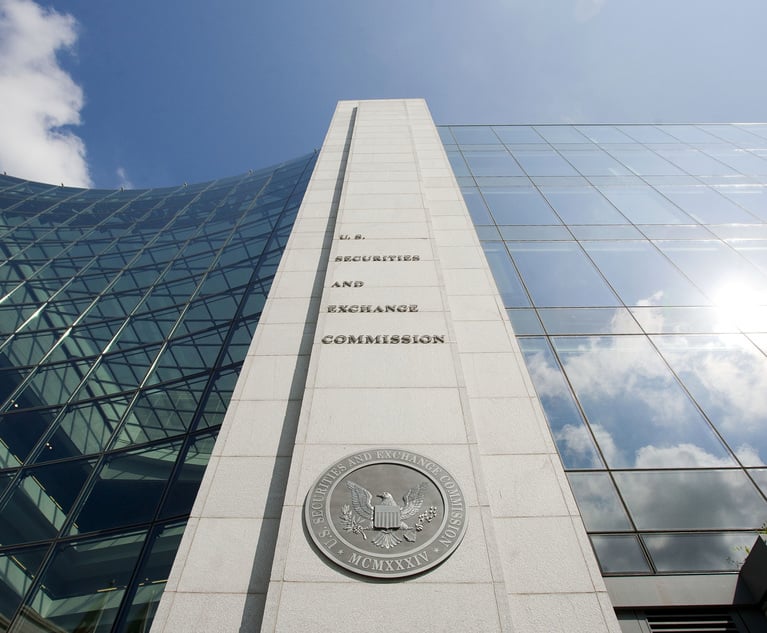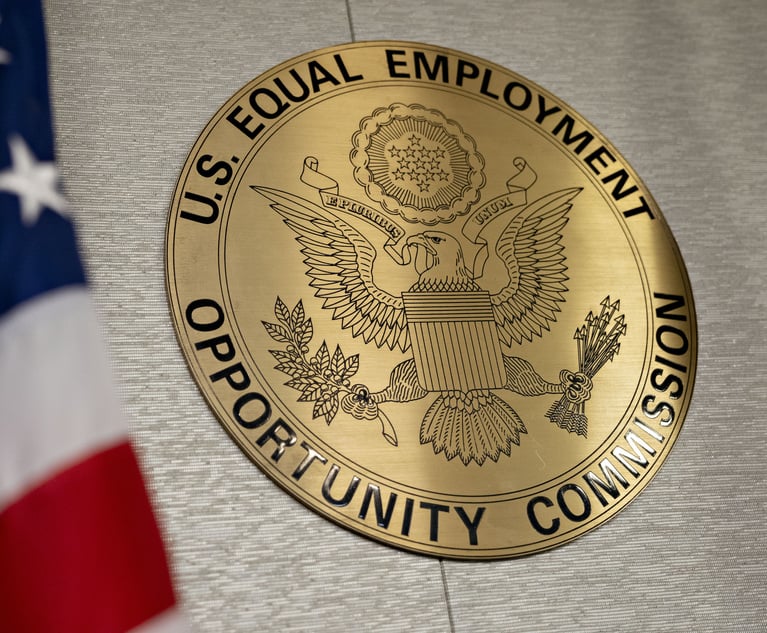7 deadly sins of “green” marketing
The color of the new millennium is definitely green. Over the past 10 years there has been a veritable explosion of the green machine, spawning a whole lexicon of green language, green expectations and green statements.
December 07, 2012 at 03:00 AM
9 minute read
The original version of this story was published on Law.com
This series, “It isn't easy being green,” will provide a brief overview of the major legal issues associated with “green” marketing claims and offer a practical framework for analyzing and reducing risk.
The color of the new millennium is definitely green. Over the past 10 years there has been a veritable explosion of the “green machine,” spawning a whole lexicon of green language, green expectations and green statements. Indeed, the green movement has hit mainstream USA in a tangible way—at the current pace it is projected that “green marketing” will account for more than $3.5 trillion in spending by 2017. Major retailers, including Wal-Mart Stores Inc., have reported a strong uptick in consumer demand for “green” and “organic” products even in a flagging economy, while the number of green products has skyrocketed virtually overnight, with growth of as much as 500 percent since 2009.
The question is, at what risk? When do green promises or representations cross the boundary from being aspirational statements to enforceable promises? And when does a clever marketing turn of phrase create litigation or regulatory risk? Opting out of the green revolution is not an option for most companies. Opting in responsibly is a business mandate.
The transparency imperative
Riding sidecar to the growing demand for green products and services is an insistence on greater transparency and meaningful substantiation of green claims. The rallying cry suggests a growing intolerance for greenwashing and related “sins.”
The term “greenwashing” is not a new one. It was coined in 1986 in reference to the hotel industry practice of encouraging reuse of towels as a green initiative, even though many hotels were making little to no effort to reduce energy waste.
In broad terms, “greenwashing,” “greenpuffing” and the “green sheen” refer to the practice of inflating the stated green benefit of an act, product or practice, typically for the purpose of achieving a marketing, public relations or profits goal. The exponential increase in “green claims” (including claims that products are natural, biodegradable, eco-friendly, non-toxic, carbon-neutral, sustainable and “certified green”)has sparked corresponding skepticism about the accuracy of those claims. While certain product categories (i.e., paper products, beauty products) are now seasoned players in the green game, other product categories, such as cleaning supplies, are relative newcomers to the field.
Neophytes to the green marketing world should expect heightened scrutiny of green claims. Newer entrants into the field, including toys and electronics, have received poor marks on reliability and accuracy of allegedly green attributes from watchdog organizations, suggesting an evolving rigor with respect to product review.
A subspecies of the broader category of false advertising claims, “greenwashing” claims typically center on exaggerations—and in some instances outright fabrications—of a product's green characteristics. Over the past few years, “seven sins” of greenwashing have emerged as the touchstone for evaluating overly ambitious green claims.
- Sin of the hidden trade-off: One of the most common greenwashing sins, this refers to the practice of highlighting one purportedly green attribute of a product, while ignoring equally or more important qualities that, when considered in totality, would prevent the product from claiming the title “green”. For example, paper manufactured from a sustainably harvested forest may not qualify as “green” if the production process itself resulted in high rates of water and air pollution or greenhouse gas emissions. The result is an exaggerated and unsubstantiated green claim.
- Sin of no proof: Companies should be able to prove all green claims (like all marketing claims) by referencing specific and accessible supporting data. Products that are touted as “green” without the benefit of appropriate substantiation are guilty of this sin.
- Sin of vagueness: Making sweeping statements such as “The product is 'all natural,'” when there is no reasonable basis for a consumer to understand any limitation on the designation falls under the heading of overly vague.
- Sin of irrelevance: This occurs where a product touts some attribute that is meaningless to consumers attempting to make environmentally preferable product selections. For example, touting a product as “chlorofluorocarbon (CFC)-free” sounds like a good thing, but is rendered meaningless with the understanding that all products are CFC-free, since CFCs are banned by law.
- Sin of lesser of two evils: Classic examples of the “lesser evil” sin include the “fuel efficient” SUV or the “organic” cigarette. Although these products might do well in a head-to-head comparison in their narrow product category, these “green” claims ignore the environmental impact of the category as a whole.
- Sin of fibbing: This is perhaps the least frequent and most aggressive type of green claim—the one that is simply made up.
- Sin of worshipping false labels: A developing area of concern, this sin refers to products that implicitly or expressly reference third-party endorsements where no such endorsement exists.
This series, “It isn't easy being green,” will provide a brief overview of the major legal issues associated with “green” marketing claims and offer a practical framework for analyzing and reducing risk.
The color of the new millennium is definitely green. Over the past 10 years there has been a veritable explosion of the “green machine,” spawning a whole lexicon of green language, green expectations and green statements. Indeed, the green movement has hit mainstream USA in a tangible way—at the current pace it is projected that “green marketing” will account for more than $3.5 trillion in spending by 2017. Major retailers, including
The question is, at what risk? When do green promises or representations cross the boundary from being aspirational statements to enforceable promises? And when does a clever marketing turn of phrase create litigation or regulatory risk? Opting out of the green revolution is not an option for most companies. Opting in responsibly is a business mandate.
The transparency imperative
Riding sidecar to the growing demand for green products and services is an insistence on greater transparency and meaningful substantiation of green claims. The rallying cry suggests a growing intolerance for greenwashing and related “sins.”
The term “greenwashing” is not a new one. It was coined in 1986 in reference to the hotel industry practice of encouraging reuse of towels as a green initiative, even though many hotels were making little to no effort to reduce energy waste.
In broad terms, “greenwashing,” “greenpuffing” and the “green sheen” refer to the practice of inflating the stated green benefit of an act, product or practice, typically for the purpose of achieving a marketing, public relations or profits goal. The exponential increase in “green claims” (including claims that products are natural, biodegradable, eco-friendly, non-toxic, carbon-neutral, sustainable and “certified green”)has sparked corresponding skepticism about the accuracy of those claims. While certain product categories (i.e., paper products, beauty products) are now seasoned players in the green game, other product categories, such as cleaning supplies, are relative newcomers to the field.
Neophytes to the green marketing world should expect heightened scrutiny of green claims. Newer entrants into the field, including toys and electronics, have received poor marks on reliability and accuracy of allegedly green attributes from watchdog organizations, suggesting an evolving rigor with respect to product review.
A subspecies of the broader category of false advertising claims, “greenwashing” claims typically center on exaggerations—and in some instances outright fabrications—of a product's green characteristics. Over the past few years, “seven sins” of greenwashing have emerged as the touchstone for evaluating overly ambitious green claims.
- Sin of the hidden trade-off: One of the most common greenwashing sins, this refers to the practice of highlighting one purportedly green attribute of a product, while ignoring equally or more important qualities that, when considered in totality, would prevent the product from claiming the title “green”. For example, paper manufactured from a sustainably harvested forest may not qualify as “green” if the production process itself resulted in high rates of water and air pollution or greenhouse gas emissions. The result is an exaggerated and unsubstantiated green claim.
- Sin of no proof: Companies should be able to prove all green claims (like all marketing claims) by referencing specific and accessible supporting data. Products that are touted as “green” without the benefit of appropriate substantiation are guilty of this sin.
- Sin of vagueness: Making sweeping statements such as “The product is 'all natural,'” when there is no reasonable basis for a consumer to understand any limitation on the designation falls under the heading of overly vague.
- Sin of irrelevance: This occurs where a product touts some attribute that is meaningless to consumers attempting to make environmentally preferable product selections. For example, touting a product as “chlorofluorocarbon (CFC)-free” sounds like a good thing, but is rendered meaningless with the understanding that all products are CFC-free, since CFCs are banned by law.
- Sin of lesser of two evils: Classic examples of the “lesser evil” sin include the “fuel efficient” SUV or the “organic” cigarette. Although these products might do well in a head-to-head comparison in their narrow product category, these “green” claims ignore the environmental impact of the category as a whole.
- Sin of fibbing: This is perhaps the least frequent and most aggressive type of green claim—the one that is simply made up.
- Sin of worshipping false labels: A developing area of concern, this sin refers to products that implicitly or expressly reference third-party endorsements where no such endorsement exists.
This content has been archived. It is available through our partners, LexisNexis® and Bloomberg Law.
To view this content, please continue to their sites.
Not a Lexis Subscriber?
Subscribe Now
Not a Bloomberg Law Subscriber?
Subscribe Now
NOT FOR REPRINT
© 2025 ALM Global, LLC, All Rights Reserved. Request academic re-use from www.copyright.com. All other uses, submit a request to [email protected]. For more information visit Asset & Logo Licensing.
You Might Like
View All

‘Extremely Disturbing’: AI Firms Face Class Action by ‘Taskers’ Exposed to Traumatic Content
5 minute read
In-House Lawyers Are Focused on Employment and Cybersecurity Disputes, But Looking Out for Conflict Over AI
Trending Stories
- 1No Two Wildfires Alike: Lawyers Take Different Legal Strategies in California
- 2Poop-Themed Dog Toy OK as Parody, but Still Tarnished Jack Daniel’s Brand, Court Says
- 3Meet the New President of NY's Association of Trial Court Jurists
- 4Lawyers' Phones Are Ringing: What Should Employers Do If ICE Raids Their Business?
- 5Freshfields Hires Ex-SEC Corporate Finance Director in Silicon Valley
Who Got The Work
J. Brugh Lower of Gibbons has entered an appearance for industrial equipment supplier Devco Corporation in a pending trademark infringement lawsuit. The suit, accusing the defendant of selling knock-off Graco products, was filed Dec. 18 in New Jersey District Court by Rivkin Radler on behalf of Graco Inc. and Graco Minnesota. The case, assigned to U.S. District Judge Zahid N. Quraishi, is 3:24-cv-11294, Graco Inc. et al v. Devco Corporation.
Who Got The Work
Rebecca Maller-Stein and Kent A. Yalowitz of Arnold & Porter Kaye Scholer have entered their appearances for Hanaco Venture Capital and its executives, Lior Prosor and David Frankel, in a pending securities lawsuit. The action, filed on Dec. 24 in New York Southern District Court by Zell, Aron & Co. on behalf of Goldeneye Advisors, accuses the defendants of negligently and fraudulently managing the plaintiff's $1 million investment. The case, assigned to U.S. District Judge Vernon S. Broderick, is 1:24-cv-09918, Goldeneye Advisors, LLC v. Hanaco Venture Capital, Ltd. et al.
Who Got The Work
Attorneys from A&O Shearman has stepped in as defense counsel for Toronto-Dominion Bank and other defendants in a pending securities class action. The suit, filed Dec. 11 in New York Southern District Court by Bleichmar Fonti & Auld, accuses the defendants of concealing the bank's 'pervasive' deficiencies in regards to its compliance with the Bank Secrecy Act and the quality of its anti-money laundering controls. The case, assigned to U.S. District Judge Arun Subramanian, is 1:24-cv-09445, Gonzalez v. The Toronto-Dominion Bank et al.
Who Got The Work
Crown Castle International, a Pennsylvania company providing shared communications infrastructure, has turned to Luke D. Wolf of Gordon Rees Scully Mansukhani to fend off a pending breach-of-contract lawsuit. The court action, filed Nov. 25 in Michigan Eastern District Court by Hooper Hathaway PC on behalf of The Town Residences LLC, accuses Crown Castle of failing to transfer approximately $30,000 in utility payments from T-Mobile in breach of a roof-top lease and assignment agreement. The case, assigned to U.S. District Judge Susan K. Declercq, is 2:24-cv-13131, The Town Residences LLC v. T-Mobile US, Inc. et al.
Who Got The Work
Wilfred P. Coronato and Daniel M. Schwartz of McCarter & English have stepped in as defense counsel to Electrolux Home Products Inc. in a pending product liability lawsuit. The court action, filed Nov. 26 in New York Eastern District Court by Poulos Lopiccolo PC and Nagel Rice LLP on behalf of David Stern, alleges that the defendant's refrigerators’ drawers and shelving repeatedly break and fall apart within months after purchase. The case, assigned to U.S. District Judge Joan M. Azrack, is 2:24-cv-08204, Stern v. Electrolux Home Products, Inc.
Featured Firms
Law Offices of Gary Martin Hays & Associates, P.C.
(470) 294-1674
Law Offices of Mark E. Salomone
(857) 444-6468
Smith & Hassler
(713) 739-1250







